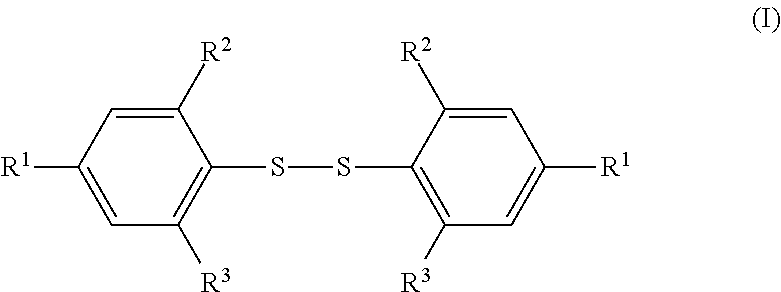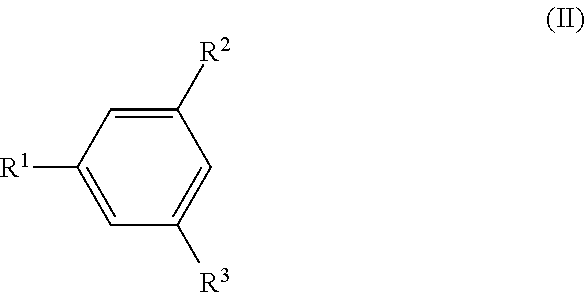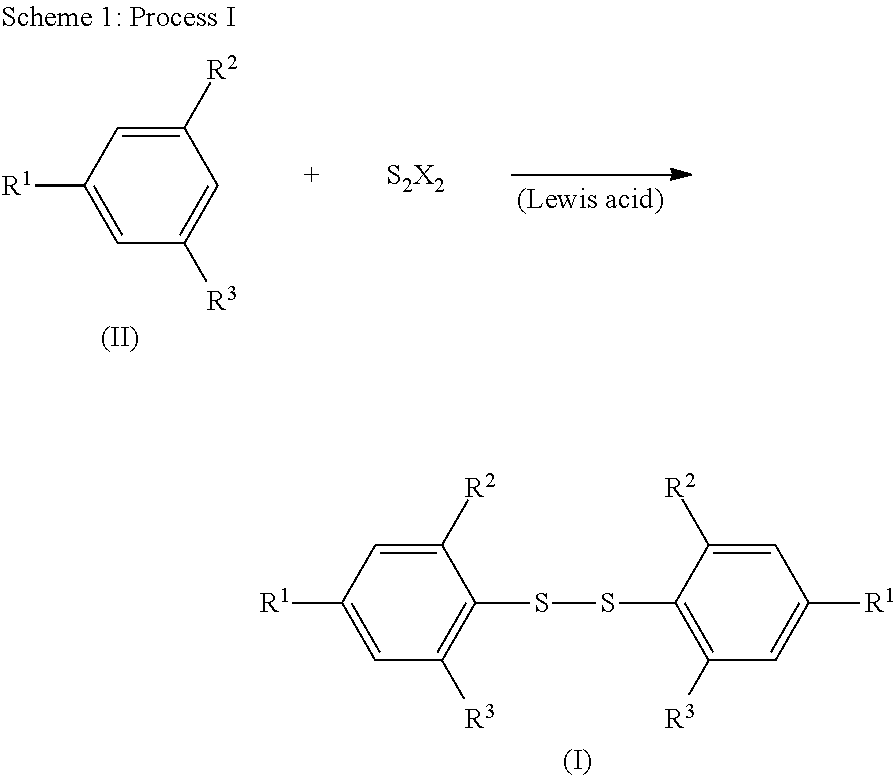Methods for Preparing Diaryl Disulfides
- Summary
- Abstract
- Description
- Claims
- Application Information
AI Technical Summary
Problems solved by technology
Method used
Image
Examples
example 1
Preparation of bis(4-tert-butyl-2,6-dimethyphenyl) disulfide (Ia)
[0026]
[0027]In a dry flask, 4-tert-butyl-2,6-dimethylbenzene (IIa) (34.39 g, 212 mmol), sulfur chloride (sulfur monochloride), S2Cl2, (14.31 g, 106 mmol), and 120 ml of glacial acetic acid were mixed. Anhydrous zinc chloride, ZnCl2, (1.8 g, 13.3 mmol; 12.5 mol % against S2Cl2) was added into the mixture while stifling. Slight heat was generated with immediate evolution of hydrogen chloride gas, which was flowed into a sodium hydroxide solution with aid of nitrogen gas flow. The reaction mixture was stirred at room temperature for 4 h. Water (300 mL) was added to the reaction mixture and the mixture was stirred at room temperature for 10 minutes. The obtained solid was filtered, washed with water three times, and dried in air. The crude product was recrystallized from isopropanol to give 32.2 g (yield 79%) of bis(4-tert-butyl-2,6-dimethylphenyl) disulfide (Ia): M.p. 127-128° C.; 1H NMR (CDCl3) δ 7.03 (s, 4H, aromatic pr...
example 2
Preparation of bis(4-tert-butyl-2,6-dimethyphenyl) disulfide (Ia)
[0028]
[0029]A dry one liter three-necked flask was set with a mechanical stirrer, internal thermometer, and nitrogen flow inlet, and outlet into a caustic scrubber solution. The flask was charged with 172.5 g (1.06 mol) of 5-tert-butyl-1,3-dimethylbenzene (IIa) and 300 mL of glacial acetic acid, followed by 43 mL (0.53 mol) of sulfur chloride, S2Cl2. The mixture was stirred for a few minutes under nitrogen flow at 20° C., and then 5.97 g (0.032 mol; 6 mol % against S2Cl2) of anhydrous zinc acetate, Zn(OCOCH3)2, was added to the mixture while stifling. The zinc acetate dissolved quickly and a rapid immediate reaction occurred with the evolution of hydrogen chloride gas, which was flowed into the scrubber solution with the aid of a flow of nitrogen gas. The reaction temperature rose to 37° C. over 2-3 minutes. The flask was cooled in a water bath so that the reaction temperature stayed below 40° C. The reaction mixture g...
example 3
Preparation of bis(4-tert-butyl-2,6-dimethyphenyl) disulfide (Ia)
[0030]The reaction of Example 3 was conducted in the same way as in Example 2 except that 1.97 g (0.011 mol; 2 mol % against S2Cl2) of anhydrous zinc acetate, Zn(OCOCH3)2, was used in place of 5.97 g (0.032 mol; 6 mol % against S2Cl2) of anhydrous zinc acetate and the total reaction time was 30 hrs.
[0031]The yield of product (Ia) was 160.4 g (78%), and the purity of the product was evaluated to be more than 99% by gas-layered chromatography.
PUM
| Property | Measurement | Unit |
|---|---|---|
| Temperature | aaaaa | aaaaa |
| Temperature | aaaaa | aaaaa |
| Fraction | aaaaa | aaaaa |
Abstract
Description
Claims
Application Information
 Login to View More
Login to View More - R&D
- Intellectual Property
- Life Sciences
- Materials
- Tech Scout
- Unparalleled Data Quality
- Higher Quality Content
- 60% Fewer Hallucinations
Browse by: Latest US Patents, China's latest patents, Technical Efficacy Thesaurus, Application Domain, Technology Topic, Popular Technical Reports.
© 2025 PatSnap. All rights reserved.Legal|Privacy policy|Modern Slavery Act Transparency Statement|Sitemap|About US| Contact US: help@patsnap.com



